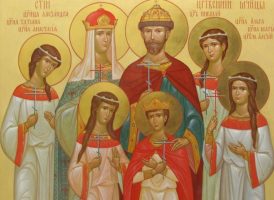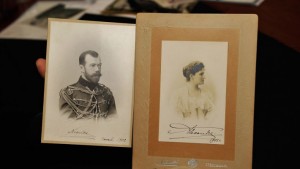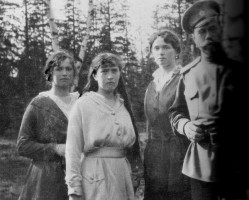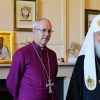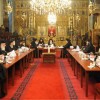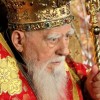07/23/2010
The Scenes of the Royal Murders Have Become Places of Pilgrimage, but the Church still Does not Recognize the Recovered Remains of the Romanovs, and Archaeologists are Fearful for the Future of the Historic Site
Alapayevsk, Sverdlovsk Region – It’s 4.20 a.m. last Sunday, the Divine Liturgy in the Holy Trinity Cathedral of this old industrial town has just finished, and several hundred people, most of them women, but quite a few men and children as well, are stepping into the pre-dawn twilight to begin a 12-kilometer procession.
“O Lord Jesus Christ, Son of God, have mercy on us, sinners,” sing the believers in time with their rather fast pace.
The Alapayevsk procession is one of the annual events which mark what are known here as the “Royal Days.” In the early hours of July 17, 1918, the deposed Tsar Nicholas II, Empress Alexandra, their five children and four servants were shot in the mining engineer Ipatyev’s house in Yekaterinburg. The following night, in Alapayevsk, 150 kilometers north-east of Yektaterinburg, the empress’ sister and founder of the famous Convent of Martha and Mary in Moscow, Grand Duchess Elizabeth, her closest aide, Sister Varvara, and five dukes imprisoned with them, were thrown alive down an abandoned mineshaft. Today these dates are remembered with a host of church services and processions, and a “festival of Orthodox culture” including exhibitions, concerts and conferences. The fifth International Festival of Orthodox Christian Documentaries is also on the agenda.
According to local police estimates, about 20,000 people walked in the early hours of Saturday morning from the imposing Church-on-the-Blood, which is built on the site of Ipatyev’s house, to the monastery at Ganina Yama 20 kilometers away. It was here that the Bolsheviks and Chekists attempted to destroy the bodies of the royal family in an abandoned mine. And although their remains have since been discovered about two kilometers away from Ganina Yama, in a place known as “Porosyonkov Log,” the vast majority of believers do not recognize this discovery, while Ganina Yama has over the past decade become one of the main holy sites in the region.
One hundred and fifty kilometers away in Alapayevsk, however, there are no debates as to the sanctity of the sites. Everything is clear and undisputed. But the remoteness of the economically depressed town of 50,000 and the lesser political overtones of the Elizabeth cult attract far fewer pilgrims. Only about 1000 people joined the Alapayevsk procession this year.
The grand duchess’ personality, however, occupies a special place among the Romanov saints. Born in Darmstadt as Princess Elizabeth of Hessen and by Rhine, and known among royals as Ella, she was raised in Britain at the court of Queen Victoria and married the uncle of Nicholas II, General-Governor of Moscow Grand Duke Sergei. She consciously and voluntarily converted to Orthodox Christianity, and with her husband took an active part in building up Russian facilities in the Holy Land. After Sergei was killed in 1905 by a revolutionary terrorist, she forgave her husband’s murderer, left the court and founded the famous Convent of Martha and Mary in central Moscow – an establishment with unique statutes, which brought up girls and cared for the sick, wounded and poor. In 1992 Elizabeth and Sister Varvara, the nun who became her chief aide, were canonized by the Moscow Patriarchate as “saint martyr nuns.” It took nearly two decades and years of dispute before Nicholas, Alexandra and their five children were also finally canonized as “passion-bearers” in 2000.
The procession passes the one-storey Napolnaya school, where Elizabeth was kept under guard until July 18. There is still a school here, and even a polling station, but one room has been turned into a museum by the sisters of the small local nunnery. Later, on the outskirts of the town, the pilgrims pass by the St. Catherine Church, where the bodies of the Alapayevsk martyrs were washed in October 1918 after anti-Bolshevist White Guard soldiers recovered them from the mine. From here they were carried to the Holy Trinity Cathedral and then through Harbin, Beijing and Shanghai, to Jerusalem, where they are kept, to this day, in the Russian Convent of Mary Magdalene in the Garden of Gethsemane.
By sunrise the pilgrims were already out of town and walking along the road to the Sinyachikha factory – along the same route that Elizabeth and her companions were carried 92 years ago. When the prisoners reached the mine they were beaten and thrown down the 20-meter-deep shaft. Hand grenades were thrown after them before they were finally burned with brushwood. According to some witnesses, hymns could be heard from the shaft for quite a while and, when the bodies were recovered in October, Elizabeth turned out to have managed to bandage one of the duke’s wounds before dying herself.
In about three hours – and the pilgrims walk at a rather fast pace – the red brick buildings of the Monastery of New Martyrs of Russia can be seen up front. It has been built around the mineshaft over the past decade. In the late 1990s, only the foundation of a church could be seen amidst the pine trees. Today, the monastery is made of several neat buildings surrounded by a red fence. Here the pilgrims venerate the cross on the side of the shaft – today it is a 2–meter-deep pit – and sit down to rest. Some return on a regular bus to Alapayevsk, but the majority stay for the Divine Liturgy, which the Archbishop Vikenty of Yekaterinburg and Alapayevsk is to celebrate here at 9 a.m. Buses with more pilgrims come one after the other. Kirill Formazov, 12, is proud to have counted 22 buses. “It is more than when the patriarch came,” the boy said referring to Patriarch Kirill’s visit here in April this year.
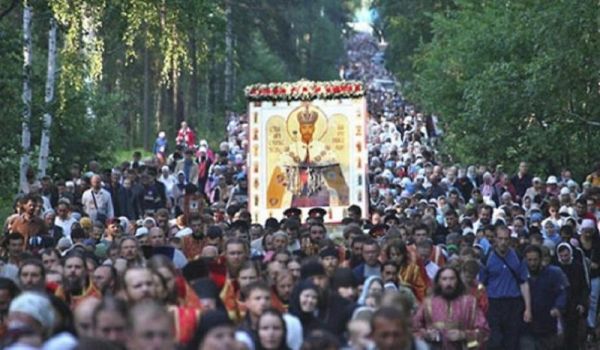
An estimated 50,000 Orthodox Christians and monarchists took part in Royal Days of 2010 in Ekaterinburg
“It is a sparkle of our small love, gratitude and thankfulness to St. Elizabeth, saint Royal Passion-Bearers, sister Varvara, all those who suffered so that our faith is alive today, so that we could be happy in our faith,” said Veronika Nesterova, a teacher of Spanish at the Urals State Unviersity in Yekaterinburg. Veronika, her husband Vasily and their two small sons – one of them in a stroller, the other on and off the stroller – have come in this procession for the second time. Veronika’s oldest daughter went the day before in the bigger procession from Yekaterinburg to Ganina Yama. “If God blesses us and give us strength, one day we will go in both processions,” says Veronika.
Around the procession
The ancient Christian tradition of long processions has been revived in Russia in recent years, and the night-long marches from Yekaterinburg to Ganina Yama and from Alapayevsk to the scene of Elizabeth’s murder are by no means the longest. Some take several days. The procession is often associated with repentance. Viktor Varnavkin, a driver from Orenburg, says that for him the procession is a “form of expressing one’s repentance,” and not only a personal one. “The procession is not a one-man enterprise,” he said, “it is both private and public – like a church service.”
The processions often attract marginal, fundamentalist trends within the church, usually connected with various unofficial cults. In Alapaevsk, while most of the pilgrims sang what is known in the Orthodox Church as the “Jesus Prayer” and carried icons of Elizabeth or the “Royal Passion-Bearers,” one group from the Volga region carried a heavy icon of the royal family and, along with it, several uncanonical icons, including the depictions of Grigory Rasputin and Ivan the Terrible with the halos of saints, and sang their own prayer asking the “Royal Martyrs” to “save Russia.” Before the liturgy a middle-aged woman stood near the gates of the monastery, singing to an old Soviet sounding melody a song that connected Orthodoxy with monarchy and denounced tax identification numbers as “Satan’s seals.”
Unlike the canonization of Grand Duchess Elizabeth, which was more or less unopposed either in the church or society at large, the canonization of the royal family was delayed several times by the church hierarchy precisely because it was vigorously promoted by such marginal groups of believers, for many of whom the belief in the “saint tsar” was closely connected with nationalist, anti-Semitic and anti-globalist ideas. The movement to canonize Nicholas was also strongly associated with a belief in the tsar’s “ritual murder” as the result of a “Judeo-Masonic conspiracy” of which the Bolsheviks were supposedly a part. The church hierarchy tried to cleanse the cult of the royal family from all of these political connotations. The “ritual murder” version was overtly rejected, as well as the heresy of “tsar-worship” (“tsareslavie”), which presumed the tsar to be the “co-redeemer” of the Russian people on a par with Jesus Christ.
However, the fundamentalists did manage to pressure the Russian Orthodox Church into not recognizing the remains of the royal family that were found in 1979 at “Porosyonkov Log,” two kilometers away from Ganina Yama. The remains were exhumed in 1991 and, after multiple examinations in Russia and abroad, were solemnly buried in the Peter and Paul Fortress in St. Petersburg in 1998, with President Boris Yeltsin and members of the Romanov family present. The cult of the royal family was formed mainly in Russian émigré circles influenced by the work of White investigator Nikolai Sokolov, who concluded that the royal remains were completely destroyed at Ganina Yama – a version that fitted well with the “ritual murder” concept.
In the 1990s, after many examinations, the investigators discovered that two bodies – those of Crown Prince Alexis and Princess Maria – were missing from the “Porosyonkov Log” remains. But in 2007, Yekaterinburg “searchers” – amateur archaeologists who search for unburied soldiers from World War II – working in conjunction with professional archeologists, found the bones of two young people buried under the ashes of a bonfire 70 meters away from the first grave. New research has proven beyond reasonable doubt that these are the remains of Alexis and Maria. But the Church has not recognized the findings and the remains, which would otherwise be venerated as the relics of saints, are kept in Sverdlovsk forensic laboratories.
Another site
While thousands of believers walked in procession to Ganina Yama, archeologist Sergei Pogorelov and “searchers” Leonid Vokhmyakov and Sergei Plotnikov, who discovered the remains of Alexis and Maria, marked the “Royal Days” in their own way. Sitting around a bonfire, they recollected the details of their discoveries. With them they had a probing rod and metal detector to look for fragments of the containers in which the Bolsheviks brought the sulfuric acid they poured over the bodies of the tsar and his children in an unsuccessful attempt to destroy them.
The sites of both graves are marked with crosses, but there is no mass pilgrimage here, only occasional small groups of visitors. One of the visitors, Tatyana Shtefanova, came to Yektarinburg from Moscow on a business trip. “Business as usual, life as usual, but you should make time to visit these holy sites,” she said.
There is a group of religious people in Yekaterinburg who venerate the graves as holy sites and lobby for church recognition of the remains, but they feel so isolated that they refused to give their names to the press.
Pogorelov and his friends, meanwhile, fear a Yekaterinburg Diocese’ plan to turn Porosyonkov Log into an “Orthodox cemetery” could destroy the historic site. Activists are trying to find support among authoritative figures to lobby against the plan, but their letters to the government and to Patriarch Kirill have not yet garnered much support.
Archpriest Vsevolod Chaplin, chairman of the Moscow Patriarchate’s Department for Relations Between the Church and Society, said the Yekaterinburg Diocese had decided that the cemetery will not overlap with the royal gravesites. “Many questions remain unanswered, and in order to close them, the investigation should be completed,” Chaplin said. “I consider it to be unfinished.”
The criminal case into the royal murders, which was briefly reopened after the discovery of Maria and Alexis, was closed again in January last year. The Romanov family has appealed that decision, however, and the Basmanny District Court in Moscow is to hear their complaint on August 25.
“For me it is obvious that this was not a petty crime, but a political decision, and it should have not only a moral, but a legal assessment as well,” Chaplin said. If the investigators consider the Ural Soviet to have made the decision to kill Nicholas and his family, it should be legally confirmed, he said.
But the vast majority of Russian Orthodox Christians have a mystical take both on the very fact of the Romanovs’ death, which they see not only as a horrible crime, but also as a birthday of new saints in Heaven, and on the arguments about the authenticity of the remains. Reasonable arguments carry pitifully little weight here.
“Most people think that the royal remains were destroyed,” said Veronika Nesterova, the pilgrim at Alapayevsk. “Perhaps something will happen, it will be made manifest to us. But when something new emerges, the attitude is: we should wait and see what comes of it.”
Source: Russia Profile.org












